Nicholas J. Clayton
Nicholas Joseph Clayton (November 1, 1840 in Cloyne, County Cork – December 9, 1916) was a prominent Victorian era architect in Galveston, Texas. Clayton constructed many grand religious and public buildings in Galveston including the First Presbyterian Church (Galveston, Texas). He is also credited as the architect of Sacred Heart Catholic Church (Tampa, Florida) and of the Main Building of St. Edward's University in Austin, Texas. He also designed an addition to St. Mary Cathedral in Galveston. "His work represents a lifetime, worked out day by day under the most ordinary and circumstantial conditions, dedicated to the cause of architecture as the public art."[1]
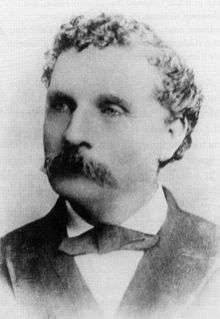
Life
Nicholas Joseph Clayton was born on November 1, 1840 (or possibly 1839),[2] in Cloyne, County Cork, Ireland, to Nicholas Joseph and Margaret O'Mahoney Clayton. In 1848, his father died in a granary accident. The widowed Margaret Clayton emigrated with her son to Cincinnati, Ohio, where her brother made shoes buckles. Young Clayton attended parochial schools. He later followed his uncle, Daniel Crowley, into the building trades, first as an apprentice plasterer and later a stone cutter. He was a Navy yeoman during the Civil War, assigned to the gunboat the USS Juliet. After the war, he returned to Cincinnati, where he became first a marble carver and then an architectural draftsman. He studied architecture with W.H. Baldwin of the Memphis firm Jones and Baldwin which sent him, in the winter of 1872, to Galveston, Texas as supervising architect for the construction of the Norman Romanesque First Presbyterian Church and the Tremont House. Upon arriving in the city, he soon met with Bishop Claude Marie Dubuis to discuss possible improvements to St. Mary's Cathedral, built in 1846. Clayton soon designed the central tower and later a new bell and statue of Mary, Star of the Sea. He remained in Galveston and set up his own office,[3] becoming one of the first professional architects to establish a practice in Texas.[4]
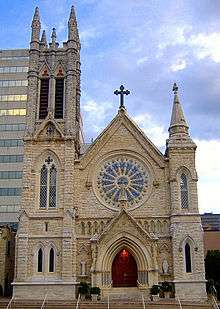
"Over the next three decades Clayton's work and influence would dominate the physical character of Galveston."[4] His first known independent work was St. Mary's Church (now St. Mary's Cathedral) in Austin (1873–84). It may have been through the Holy Cross fathers that the bishop connected Nicholas Clayton with St. Mary's in Austin.[5] In a 2013 interview regarding the ongoing restoration, Cathedral Rector Albert Lafloret observed that, when finished, "then you'll really see how beautiful the work is that's been done and what a glorious plan Nicholas Clayton had."[6]
A devout Catholic who attended daily mass, Clayton designed buildings for the Congregation of the Sacred Heart, as well as numerous parishes throughout the diocese of Galveston, Dallas, and Alexandria, Louisiana. He also produced major church and institutional buildings for Catholic religious orders, especially the Sisters of Charity of the Incarnate Word, the Ursuline Sisters, the Jesuits, and the Congregation of Holy Cross. His religious architecture accounted for the broadest geographical distribution of his work outside Galveston.[3] These demonstrate his self-assured free eclecticism and his interpretation of contemporary French and British styles.
Clayton had a particular affinity for ecclesiastical architecture and his work spanned a number of faiths, including the Eaton Chapel at Trinity Episcopal, Temple B'Nai Israel, and Grace Episcopal Church.
Nicholas Clayton is described as 5 feet 10 inches with pale blue eyes and closely cropped curly brown hair, which he wore longer as it turned gray. Robust and active, he liked to walk and to swim in the Gulf. He was a member of The Knights of Columbus, and The Ancient Order of Hibernians. In 1873 he brought his mother to Galveston, where they lived in a cottage on the outside of town. A tireless worker he was noted for his bold style, attention to detailing, and professionalism. It was his custom to work six days a week, excluding Sundays and Christmas, although he rarely spent much time in his office on Postoffice Street.[2] In 1887, he oversaw sixty-four projects. A meticulous perfectionist about his work, Clayton was quiet and reserved with a mild sense of humor. For many years, he devoted his free time to the children at St. Mary's Orphanage, and managed the annual New Year's Eve fireworks display.[7]
In 1877 he went into business with fellow-Irishman, civil engineer Michael L. Lynch. The firm of Clayton and Lynch lasted until 1881. Lynch subsequently re-located to Fort Worth. Clayton's uncle, Daniel Crowley, joined him from Cincinnati and handled the modelling and embellishment of the Eaton Memorial Chapel of Trinity Protestant Episcopal Church. The Galveston Electric Pavilion was the first building in Texas with electric lighting. Before designing the University of Texas Medical Building, he first took a tour of Johns Hopkins, the New York College of Physicians and Surgeons, and Harvard.[7]
On July 6, 1891, Clayton married a much younger Mary Lorena Ducie, in a marriage possibly arranged by her father, Daniel W. Ducie, a Confederate veteran and friend of Clayton's and the painting contractor with whom he worked most closely. The couple honeymooned in Monterey, Mexico, where according to family lore, Clayton spent so much time sketching churches that his bride hinted that she might return to Galveston. They purchased a house on 35th Street, where they raised five children. His son, Nicholas Jr. became an electrician. The worst name Clayton ever called anyone was "muttonhead," according to family reminiscences. He told his boys their mouths were for praying and eating.[2]
He was a charter member of the Association of Texas Architects, and a fellow of the American Institute of Architects.[7]
After 25 years as the premier architect of the city, just after the turn of the century, Clayton, for a variety of reasons, suffered a swift and painful professional decline. Commissions suffered while the community focused on recovering after the hurricane. Then too, Clayton was more of an artist, than conscientious businessman, and perhaps relied to much on others for that part of the business. A bid to build Galveston's new county courthouse was accepted while Clayton was out of state on a project. The firm forfeited on a bond and become involved in a lengthy lawsuit, which he ultimately lost, and Clayton was forced to initiate bankruptcy proceedings. Clayton later served on an advisory board for the construction of the dome of the Capitol in Austin. His last known commission was adding the dome to Galveston's Sacred Heart Church in 1910.[8]
Nicholas Clayton was repairing his own chimney by the light of a candle in November 1916 when his wool undershirt caught on fire and he was severely burned. Despite otherwise excellent health, he succumbed to pneumonia on Dec. 9, 1916 at the age of seventy-six, having lived in Galveston 45 years.[2] He was buried in Galveston's Calvary Catholic Cemetery. His burial site was marked with one of his marble samples because his family could not afford a gravestone.[1] When Mrs. Clayton grieved to their friend Rabbi Henry Cohen, of having no money for a proper monument, Rabbi Cohen is said to have replied, "Oh, you don't need one, my dear Mary Lorena. He's got them all over town. Just go around and read some cornerstones."
In 2015, in recognition of Clayton's 175th birthday, the city of Galveston declared Sunday November 1 as "Nicholas Clayton Day".[8]
Style
Clayton was a High Victorian architect with a "spirited, picturesque, eclectic" approach.[1] His buildings were exuberant in shape, color, texture, and detail. The University of Texas Medical Building mixes Romanesque arcades with Spanish Baroque parapets, Italian Gothic gables, and vaguely Moorish pinnacles.[4]
Clayton excelled at decorative brick and iron work, and took full advantage of the skills of the masons and bricklayers who had immigrated to Galveston from Western Europe. His High Victorian predilections were evident not only in his buildings of the 1870s, but in those influenced by the Queen Anne movement of the 1880s, the Richardsonian Romanesque movement of the late 1880s and 1890s, and the revival of Renaissance classicism after 1890. An academic distribution of space in institutional structures, and unencumbered loft space in commercial buildings were typical of his work. What made Clayton's architecture so distinctive in late nineteenth-century Texas was the underlying compositional and proportional order with which he structured the display of picturesque shapes and rich ornament.[3]
His papers and drawings are held at the Alexander Architectural Archive at the University of Texas in Austin,[1] and in the Galveston and Texas History Center of the Rosenberg Library, Galveston.
Notable buildings
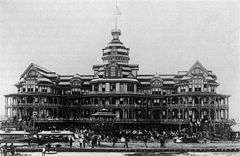
About fifty of Clayton's buildings remain in Galveston today. Many were destroyed in the great fire of November 1885 that wiped out forty-five blocks of the city. The Galveston Pavilion built about 1881, burned down in 1883. Harmony Hall, also built about 1881, burned in 1928. The flamboyant Beach Hotel, built in 1882, burned to the ground in 1888, while Clayton watched from his bed. Sacred Heart Church was so severely damaged by the hurricane of 1900 that it had to be demolished.[4] The Ursuline Academy in Galveston, built about 1894, was one of Clayton's largest and most important architectural design. It was demolished in 1962 after sustaining damage from the 1961 Hurricane Carla.
The Galveston Historical Foundation worked with owners and the city to have those remaining designated historical landmarks.[8]
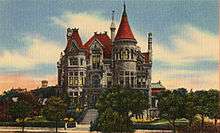
The Bishop's Palace, Galveston was originally built in 1887 for railroad entrepreneur Col. Walter Gresham. Clayton was heavily involved in the design of the interior spaces of the mansion. The front parlor fireplace was purchased in 1876 at the Philadelphia World's Fair, where it had won a first prize. The house was one of the first in the region to be fully equipped for gas and electric fixtures. Sold in 1923 to the Diocese of Galveston, it was one of the few structures that sustained little damage from the 1900 hurricane.[9] During the storm, Josephine Gresham and her staff formed a human chain out into the swirling water to reach those struggling. Many found sheltered within "Gresham's Castle"'s behind the twenty-three inch think walls, finding lodging throughout the sturdy mansion's fifty-two rooms spread over 20,000 square feet of the Victorian mansion.[10] Architectural historians list the Bishop's Palace as one of the most significant of Victorian residences in the country.[8]
The gingerbread-latticed Garten Verein, a popular wedding venue on Ave. O in Galveston, was for many years the social center of Galveston's large German community.[2]
Works
- St. Mary's Church - Gothic Revival (1873)
- Ball High School (Galveston)
- St. Mary's Infirmary, Galveston (1874–76, demolished)
- Dallas Orphan Asylum
- St. Patrick's Church, Galveston (1874–77, reconstruction 1901–02)
- Mr. and Mrs. George Seeligson residence (1875)
- W. L. Moody Building
- Mr. and Mrs. Lemuel Burr House (1876)
- Mr. and Mrs. Isidore Lovenberg House (1877)
- Bolton Estate Building (1877)
- Wallis, Landes and Company (1877)
- George Schneider and Company (1877)
- Eaton Memorial Chapel, Trinity Episcopal Church, Galveston (1878–79)
- Stafford Bank and Opera House
- Ursuline Academy, Dallas (1882) -demolished[11]
- Beach Hotel (Galveston) (1882)
- H.M. Trueheart & Co. Building (1882)
- Greenleve, Block & Co. Building (1882)
- *Galveston News Building (1884)
- Sonnentheil House (1886)
- Gresham's Castle - Victorian (1887-1892)
- Trueheart-Adriance Building
- Temple B'Nai Israel (1887)
- Incarnate Word Academy, Houston (1888–89 and 1899, demolished; 1905, extant);
- St. Matthews Catholic Church (Monroe, La.)
- St. Edward's University (Main bldg. and Holy Cross dormitory), Austin (1888)
- Rudolph Kruger Home (1888)
- St. Patrick's Catholic Church (Galveston)
- Sacred Heart Church, Palestine, Texas (1890)
- Ursuline Convent (Dallas)
- John Sealy Hospital
- Ashbel Smith Building - Romanesque Revival (1891)
- Bishop's House, Galveston
- Ursuline Academy, Galveston (1891–95, demolished);
- St. Joseph's Infirmary, Houston (1892–94, 1895, demolished).
- Grace Episcopal Church, Galveston (1894)
- Sealy Hutchings Building (1895)
- St. Francis Xavier Cathedral (Alexandria, Louisiana) - Gothic Revival (1895)
- Hutchings-Sealy Building (Galveston) (1896)
- St. Patrick's Church, Denison (1896–98);
- Sacred Heart Cathedral, Dallas - Gothic Revival (1896)
- Sacred Heart Catholic Church (Tampa, Florida) - Romanesque Revival (1905)
- St. Matthew's Catholic Church, Monroe, Louisiana (1905)
- the dome of the second Sacred Heart Church, Galveston (1912)
Gallery

 Old Red Building, University of Texas Medical Branch, Galveston
Old Red Building, University of Texas Medical Branch, Galveston Main Building, St. Edward's University, Austin
Main Building, St. Edward's University, Austin Sacred Heart, Tampa, Fla.-interior
Sacred Heart, Tampa, Fla.-interior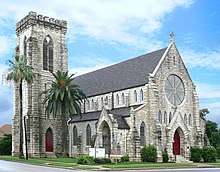 Grace Episcopal Church, Galveston, Texas
Grace Episcopal Church, Galveston, Texas
References
- "Nicholas Joseph Clayton", Alexander Architectural Archive, University of Texas, Austin
- Canright, Marsha. "Island celebrates renowned architect", Coast Monthly, October 24, 2015
- Handbook of Texas Online, Robert A. Nesbitt and Stephen Fox, "Clayton, Nicholas Joseph,"
- Speck, Larry. "Old Red, University of Texas Medical School Galveston", Landmarks of Texas Architecture, (1986), University of Texas Press
- "History", Saint Mary Cathedral
- Castillo, Juan. "St. Mary Cathedral gets a face-lift", American-Statesman, February 2, 2013
- Wooten, Heather Green. Old Red: Pioneering Medical Education in Texas, Texas A&M University Press, 2013, ISBN 9780876112946
- "GHF and the City of Galveston Celebrate Nicholas Clayton’s 175th Birthday on November 1", Galveston Historical Foundation
- Speck, Larry. "The Bishop's Palace", Landmarks of Texas Architecture, (1986), University of Texas Press
- Card, Terry. "The Bishop’s Palace: Galveston’s Most Significant Building", Island Guide
- "Bosse, Paula. "Nicholas J. Clayton’s Neo-Gothic Ursuline Academy", Flaskback: Dallas
Further reading
- Barrie Scardino and Drexel Turner (2000). Clayton's Galveston : the architecture of Nicholas J. Clayton and his contemporaries. College Station: Texas A&M University Press. ISBN 0-89096-881-0.
External links
| Wikimedia Commons has media related to Nicholas J. Clayton. |
- Nicholas Joseph Clayton from the Handbook of Texas Online
- Photos of Clayton's work